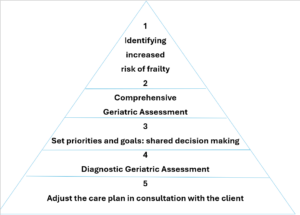Pyramid of Buurman
The Pyramid of Buurman consists five steps that have to be carried out by different care providers.

- Step 1: Both a caregiver and a nurse have the responsibility to identify in which areas the client may be frail.
- Step 2: A nurse has the responsibility to perform a Comprehensive Geriatric Assessment
- Step 3: Priorities and goals can be set in consultation with the client and informal caregivers. Which problems/ goals are important to the client for which he is motivated to do something about it?
- Step 4: Only the problems that the client recognizes and wants to do something about are further investigated by performing a Diagnostic Assessment. The client should be referred to a specialised nurse in geriatric care who is competent to perform a Diagnostic Geriatric Assessment.
- Step 5: Both caregiver and nurses are competent to adjust the care plan.
The diagnostic assessment (Step 4) is carried out by a specialised nurse (Bachelor nurse, Geriatric nurse) and the (GP) doctor and para-medical professionals. The condition is that the client recognizes the problems and wants to do something about them (Step 3).
The purpose of the diagnostic assessment is to gain more insight into the causes of the problem and the connection with other vulnerabilities. During the diagnostic assessment, disturbances in the organ systems, other geriatric problems, personality characteristics, social function characteristics, life history, residual capacity and use of aids are examined.
Bron:
Calibris (2014) Landelijke Kwalificaties MBO verpleegkundige en Calibris (2014) Landelijke kwalificaties MBO verzorgende IG.
Buurman B. in : Bakker T., Habes V., Quist, G., Van der Sande, J., Van de Vrie, W. (2019) Klinisch redeneren bij ouderen. Functiebehoud in levensloopperspectief. Bohn Stafleu van Loghum.


